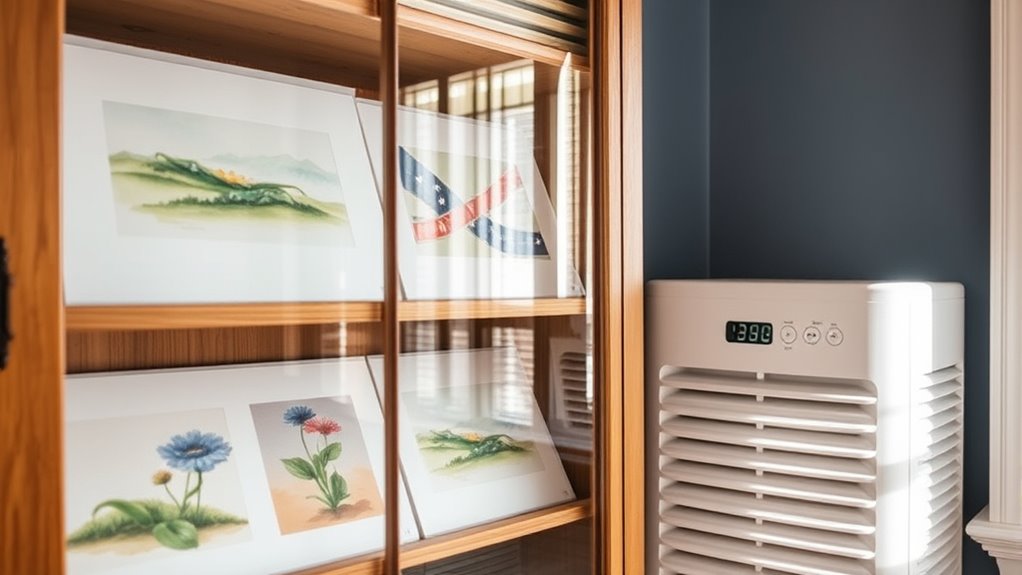To keep your artwork safe at home, monitor humidity levels regularly with reliable sensors and adjust humidifiers or dehumidifiers as needed to stay between 40-50%. Store pieces in a stable environment away from sunlight, drafts, and heat sources. Use acid-free containers and handle your art carefully with gloves. Maintaining consistent temperature and humidity helps prevent damage. To learn more about creating the perfect storage space, keep exploring these tips.
Key Takeaways
- Use reliable, calibrated humidity sensors and data loggers to monitor levels continuously.
- Maintain indoor humidity between 40-50% using humidifiers or dehumidifiers as needed.
- Store artwork in a stable, climate-controlled environment away from sunlight and drafts.
- Use acid-free, archival-quality containers and handle artwork with care and proper support.
- Regularly check and adjust climate control devices, and review humidity levels to prevent fluctuations.
Monitor and Control Humidity Levels Regularly
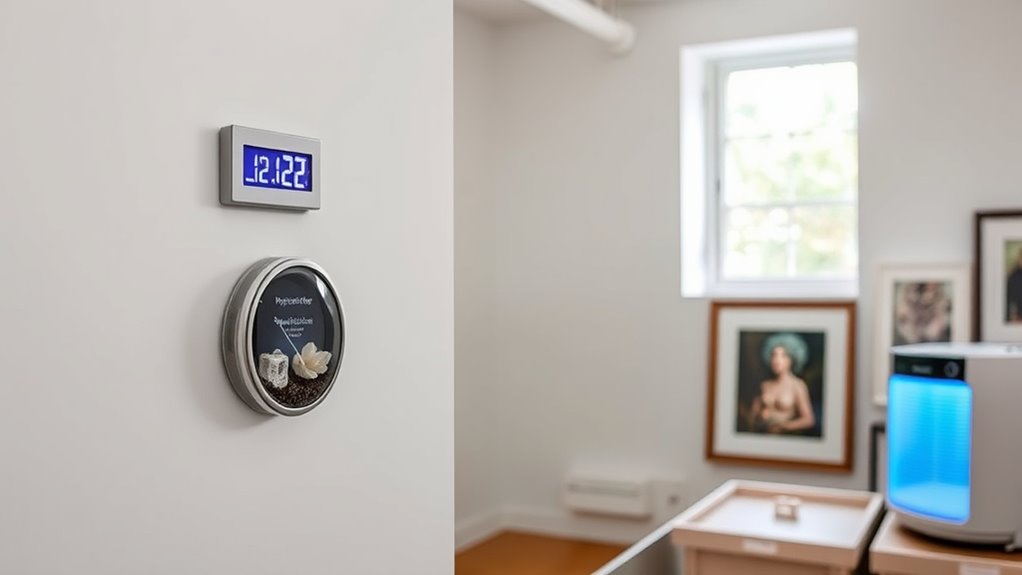
To protect your artwork effectively, you need to monitor and control humidity levels regularly. Start by using reliable sensors that require proper calibration to guarantee accurate readings. Regular sensor calibration helps you maintain precise humidity measurements, preventing fluctuations that could harm your pieces. Data logging is equally important; by recording humidity levels over time, you can identify patterns and respond promptly to any changes. Set up your sensors in key areas where your artwork is stored, and check their calibration periodically. Use data logs to track trends and adjust your environment as needed. Maintaining a consistent humidity level is crucial for preserving artwork, reducing risks of warping, cracking, or mold growth. Staying vigilant ensures your art stays protected and preserved for years to come.
Choose the Right Storage Environment and Location

Selecting the right spot for your art storage is essential. Aim for a room with stable temperatures and consistent humidity, avoiding areas prone to temperature swings. Also, don’t overuse humidifiers, as too much moisture can harm your artwork. Incorporating proper workspace setup can further help maintain optimal conditions and protect your collection.
Ideal Room Conditions
Choosing the right room for storing your artwork is essential to maintaining its condition. Look for a space that stays consistently cool and dry, avoiding direct sunlight, which can cause fading. A room with minimal foot traffic reduces vibrations that might damage delicate pieces. This space can serve as both an inspiring environment for your artistic inspiration and a decorative display area, so keep it neat and well-organized. Guarantee the room has good airflow to prevent mold and mildew buildup. Keep windows covered or sealed to control light exposure. Avoid areas near heating vents or fireplaces, as fluctuating humidity levels can harm your collection. By selecting an ideal room, you create a stable environment that preserves your art’s beauty over time. Ensuring the space has proper humidity control is crucial for preventing deterioration and maintaining the artwork’s integrity over the years.
Minimize Temperature Fluctuations
Maintaining a stable temperature is essential for protecting your artwork from damage caused by fluctuations. Sudden heat fluctuation can cause materials to expand and contract, leading to cracking, warping, or paint delamination. To guarantee temperature stability, choose a storage location away from windows, radiators, and vents where heat sources can cause uneven temperature changes. Avoid areas prone to drafts or direct sunlight, as these can create unpredictable temperature shifts. Keep your storage space consistent by using insulated containers or climate-controlled cabinets if possible. Regularly monitor the temperature with a reliable thermometer to catch any fluctuations early. Additionally, selecting a space that resembles a bedroom with a cozy ambiance can help in maintaining a calm environment conducive to preserving your artwork’s integrity and longevity. By selecting the right environment and maintaining steady temperatures, you help preserve your artwork’s integrity and longevity.
Avoid Humidifier Overuse
Ensuring your storage environment isn’t overly humid is key to preventing damage from excess moisture. Humidifier misuse can lead to overhumidification risks, which may warp, mold, or stain your artwork. To avoid this, don’t rely excessively on a humidifier, especially in already stable environments. Instead, monitor humidity levels regularly with a hygrometer and aim for a consistent range, typically between 40-50%. Overhumidification can cause condensation and promote mold growth, so use humidifiers sparingly and only when needed. Place your art in a location away from windows, vents, or sources of direct moisture. Proper placement and careful control of humidity levels help prevent overhumidification risks and keep your artwork safe from moisture-related damage. Additionally, maintaining a vetted storage environment ensures optimal protection for your collection.
Use Appropriate Storage Materials and Containers
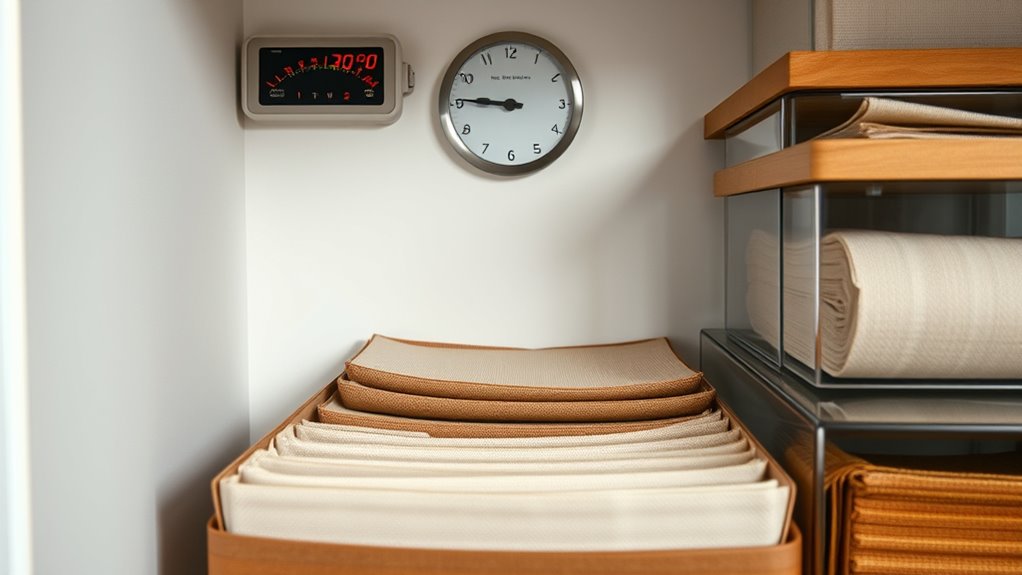
To protect your artwork effectively, selecting the right storage materials and containers is essential. Use archival quality, acid-free materials to prevent deterioration over time. Acid-free boxes, folders, and tissue paper guard against acids that can cause fading or damage. Avoid using cardboard or plastic containers that aren’t labeled as archival quality, as they may off-gas harmful chemicals or trap moisture. Guarantee your storage containers are sturdy and well-ventilated to help maintain consistent humidity levels. Label your containers clearly for easy identification without unnecessary handling. Properly chosen materials prevent long-term damage from environmental fluctuations and keep your artwork safe. Investing in quality, acid-free storage options ensures your art remains preserved and vibrant for years to come. Additionally, using appropriate storage materials can help control humidity levels and prevent mold growth, further safeguarding your artwork.
Employ Climate Control Devices for Consistent Conditions

Choosing the right climate control device is key to maintaining stable conditions for your art. You should regularly check humidity levels and adjust the device settings as needed. This guarantees your artwork stays safe and well-preserved over time. Incorporating automation’s role in business intelligence can also help monitor environmental data continuously, ensuring optimal storage conditions.
Choose the Right Device
Selecting the right climate control device is essential for maintaining stable humidity levels in your art storage area. Your device selection should be based on the size of your space, the type of artwork, and your budget. For small to medium art storage, a dehumidifier or humidifier with adjustable settings works well. If you’re storing valuable or sensitive pieces, consider a digital climate control system that offers precise humidity regulation. Portable units are convenient for temporary setups, while built-in systems suit long-term storage needs. Always choose a device that can handle the volume of your space efficiently, preventing fluctuations that could harm your artwork. Proper device selection ensures your art remains protected and preserves its condition over time. Additionally, integrating AI-powered climate control devices can optimize environmental stability through real-time monitoring and adjustments.
Monitor Humidity Levels Regularly
Regularly monitoring humidity levels is essential to guarantee your art storage environment remains stable. Consistent readings help you detect fluctuations that could threaten your art’s preservation. Use reliable humidity sensors to track conditions accurately, ensuring your space stays within the ideal range for art preservation. Digital hygrometers are user-friendly and provide instant updates, making it easy to maintain perfect humidity levels. Keep a log of sensor readings to identify patterns or sudden changes. This proactive approach helps prevent damage caused by excessive dryness or moisture. Regular monitoring also guides you in making informed adjustments to your climate control devices, ensuring your art remains in a stable environment. Employing precise measurement tools is crucial for effective art preservation. Consistent vigilance with humidity sensors is key to safeguarding your collection’s longevity.
Adjust Settings as Needed
Once you’ve monitored humidity levels and identified any fluctuations, it’s important to adjust your climate control devices to maintain stable conditions. For effective art storage, humidity adjustment is vital. If the environment becomes too dry or too humid, tweak your humidifier or dehumidifier accordingly. Set your humidifier to increase moisture if levels drop below 40%, or lower it if they rise above 60%. Use a hygrometer to verify changes and ensure consistent conditions. Regularly reviewing and fine-tuning your devices helps prevent damage to your artwork. Remember, small adjustments make a significant difference in preserving your art’s integrity. By employing proper climate control and humidity adjustments, you create a stable environment that protects your collection over the long term. Additionally, understanding AI security vulnerabilities can help in implementing smart climate control systems that adapt to changing conditions.
Implement Proper Handling and Packing Techniques
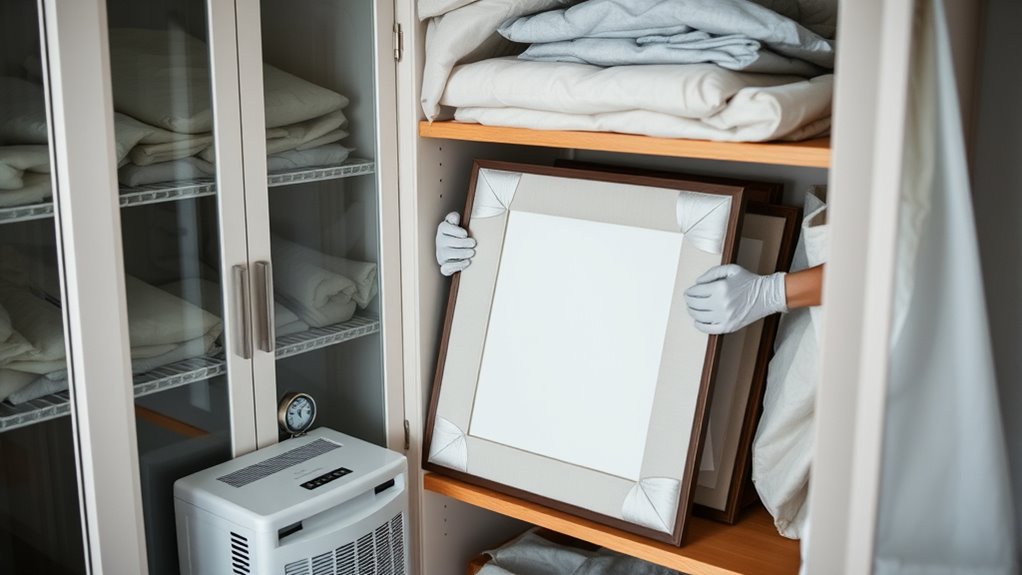
To guarantee your artwork remains protected during handling and packing, it’s vital to follow proper techniques that minimize risk of damage. Use gentle handling techniques, supporting the artwork from the back and avoiding direct contact with the surface. When packing, choose appropriate materials like acid-free tissue, bubble wrap, and sturdy boxes to prevent scratches, tears, or breakage. Secure the piece firmly but avoid tight packing that might cause pressure damage. Use corner protectors and cushioning to prevent movement inside the packaging. Always handle artwork with clean, dry hands or gloves to prevent smudges and oils. Carefully label packages as fragile, and store them upright to minimize stress. Proper handling techniques and packing methods ensure your artwork stays safe during storage and transport. Additionally, understanding the celebrity lifestyle insights can inspire personalized touches in your display or storage solutions.
Maintain a Stable Temperature to Complement Humidity Control
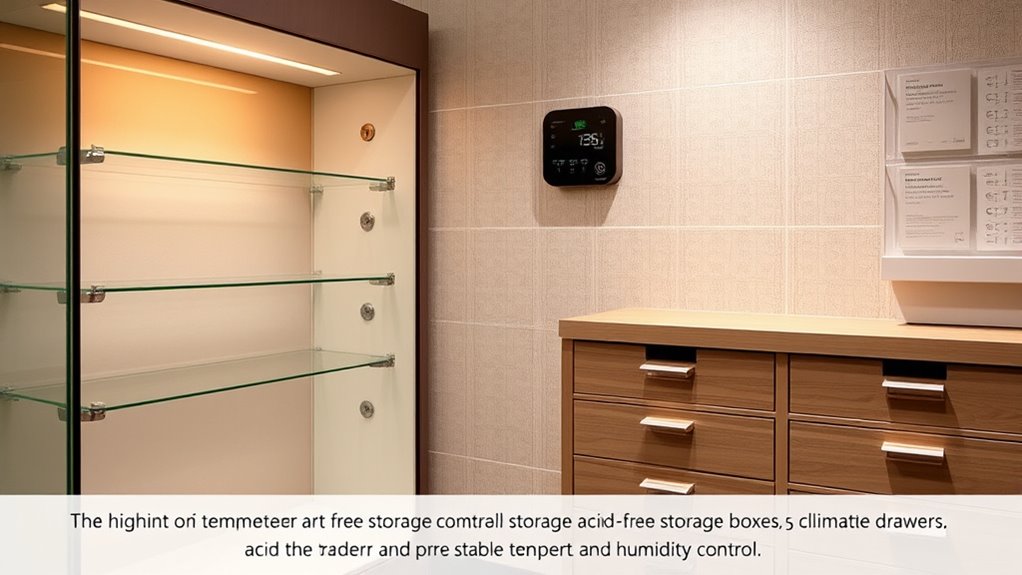
Maintaining a stable temperature is essential for protecting your artwork, as fluctuations can cause materials to expand and contract, leading to cracks, warping, or other damage. Consistent temperatures support art preservation and ensure environmental stability. Aim for a temperature range of 65-75°F (18-24°C). Avoid rapid changes or extremes, which stress materials. Keep your storage area away from direct sunlight, heating vents, or drafts. Use a thermometer to monitor conditions regularly. Regular environmental monitoring can help detect fluctuations early and prevent damage.
Frequently Asked Questions
How Can I Detect Humidity Fluctuations Without Specialized Equipment?
You can detect humidity fluctuations without specialized equipment by using DIY hygrometers or humidity indicator strips. A DIY hygrometer, made with household items like a glass jar and a sponge, helps you monitor changes over time. Humidity indicator strips, placed near your artwork, change color with moisture levels. Regularly checking these simple tools lets you identify fluctuations early, so you can adjust your environment to protect your art.
What Are the Best Natural Ways to Regulate Humidity at Home?
You can naturally regulate humidity at home using DIY dehumidifiers like charcoal or silica gel packs, which absorb excess moisture. Plant-based humidifiers, such as houseplants like ferns or peace lilies, release moisture into the air, helping maintain balance. Keep windows open during dry weather to promote airflow, and use bowls of water near heat sources to add humidity when needed. These methods are eco-friendly and cost-effective.
Can Household Items Help Stabilize Humidity for Artwork Storage?
Household items can help stabilize humidity for your artwork storage. Use humidity sensors to monitor moisture levels accurately, ensuring ideal conditions. Placing a dehumidifier in strategic spots, like near windows or damp areas, can effectively control excess moisture. Additionally, using household items like silica gel packs or moisture absorbers can help maintain stable humidity. Regularly check your sensors and adjust dehumidifier placement as needed to protect your art.
How Often Should I Inspect My Storage Environment for Issues?
You should inspect your storage environment at least monthly to catch issues early. During inspections, check climate control systems to maintain stable humidity levels, and look for signs of pests that could damage your artwork. Regular monitoring helps prevent mold, warping, or pest infestations, ensuring your art stays in good condition. Consistent inspections also allow you to adjust climate control and pest prevention measures as needed for ideal preservation.
Are There Specific Signs Indicating Humidity Damage on Artwork?
Think of your artwork like a sponge; signs of humidity damage include mold growth, which looks like fuzzy spots or discoloration, and paint cracking, resembling a dried riverbed. If you notice these issues, it’s a clear sign that the environment’s humidity isn’t ideal. Regular inspections help catch these problems early, preventing further deterioration. Keep an eye out for any unusual textures or spots—it’s your artwork’s way of signaling trouble.
Conclusion
By regularly monitoring humidity levels and using the right storage techniques, you can protect your artwork from damage. Did you know that fluctuations in humidity are responsible for up to 80% of art deterioration? Keeping your art in a stable environment not only preserves its beauty but also extends its lifespan. So, stay vigilant, invest in climate control devices, and handle your pieces carefully—your artwork will thank you for it in the years to come.
